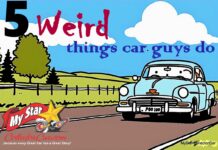Motor Trend just hit the eject button on most of its car guy shows, but the biggest casualty was Roadkill.
Roadkill was a pioneer in the YouTube arena when the show debuted in 2012, and it exploded with over a million viewers per episode.
Jerry Sutherland
There were many reasons for its success and an equal number of reasons for its cancellation but give Roadkill credit—it redefined car guy TV.

Prior to Roadkill, car guy TV was made up of shows where fake stories undermined the reality of the show. These shows were thin in information and fat in noisy personality and bad plots.
I wasn’t a disciple of the show, but I did watch Roadkill regularly because I liked their fresh approach to covering the car hobby. The two main guys (David Freiburger and Mike Finnegan) had a road trip mentality and that is what I really liked about the show.

They set the blueprint for car guy shows to follow because they did the right thing and hit the road in old iron. There’s a fundamental truth at MyStar—road warriors are the highest level of car guy. The Roadkill guys were definitely road warriors—especially in their younger days.

Roadkill pushed the limits in many ways. In some cases, pushing the limit came from what they built—monsters like Stubby Bob (a 1950 Ford F-6 dump truck). They built Stubby Bob to do wheel stands via a rear-mounted 454 big block and an insanely shortened wheelbase.
That’s not something I would build because an old Ford dump truck has its own built-in cool factor. But I’ve met thousands of car guys who would (or have) built similar contraptions. It’s all part of the car guy mantra to be bigger, faster and yes–dumber.
My favorite Roadkill episodes came when they took incredibly flawed cars or trucks on long road trips. In some cases, they’d buy a car like a ’72 Pontiac four-door for 1500 bucks and head out on a 1500-mile road trip on a very limited travel budget.

They made stars out of trashed cars like a Crusher Impala (1969 Chevy) with a massive Chevy big block; the General Mayhem (’68 Charger) or the Vette Kart (’84 Vette).

These were all cars with a bleak feature and Roadkill turned them into stars.
That’s the good part, but there were some potholes on the Roadkill highway. They’d pump nitrous into tired old stock small blocks and wonder why the engine would grenade. In fact, they grenaded enough motors to run a fleet of Amazon delivery trucks in a medium-sized city.

Freiburger was amped-up 24-7 on Roadkill so he constantly shout-talked like he was next to an F-18 on runway warm up. Finnegan had his own demons—he thought every minor close call on a road trip was a near-death experience.
Those weren’t deal-breakers—even with the obvious production guys all over the place in every episode. Roadkill was heavily sponsored on both YouTube and Motor Trend, so their real-world risk on a road trip was minimized.

In the end, what really killed Roadkill is what’s killing mainstream TV. YouTube and many other online venues are siphoning off viewers faster than high taxes drive investment away from countries.
Basically, Roadkill was road killed by the very thing that made it popular.
Jerry Sutherland
By: Jerry Sutherland
Jerry Sutherland is a veteran automotive writer with a primary focus on the collector car hobby. His work has been published in many outlets and publications, including the National Post, Calgary Herald, Edmonton Journal, Ottawa Citizen, Montreal Gazette, Saskatoon StarPhoenix, Regina Leader-Post, Vancouver Sun and The Truth About Cars. He is also a regular contributor to Auto Roundup Publications.
- CLICK HERE TO SIGN UP FOR THE NEWSLETTER
- CLICK HERE to Like us on Facebook
- CLICK HERE to Follow us on Twitter
- CLICK HERE to Follow us on Pinterest
Please re-post this if you like this article.






















































